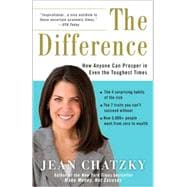
What is included with this book?
| Acknowledgments | p. ix |
| Introduction: What's the Difference? | p. 1 |
| Meet the Neighbors | p. 10 |
| Choosing The Difference | p. 36 |
| Do I Have to Be a Rocket Scientist or a PhD? | p. 58 |
| Ding, Dong, Your Passion Is Calling | p. 77 |
| Get Happy (But Not Too Happy) | p. 96 |
| In Praise of the Do-Over | p. 119 |
| Taking Risks That Make Sense | p. 140 |
| The Kevin Bacon Principle | p. 162 |
| Grazie | p. 181 |
| Working Hard and Working Smart | p. 194 |
| The Healing Power of Saving | p. 216 |
| Make Your Money Work for You | p. 236 |
| Afterword | p. 257 |
| Index | p. 259 |
| Table of Contents provided by Ingram. All Rights Reserved. |
The New copy of this book will include any supplemental materials advertised. Please check the title of the book to determine if it should include any access cards, study guides, lab manuals, CDs, etc.
The Used, Rental and eBook copies of this book are not guaranteed to include any supplemental materials. Typically, only the book itself is included. This is true even if the title states it includes any access cards, study guides, lab manuals, CDs, etc.
Excerpted from The Difference: How Anyone Can Prosper in Even the Toughest Times by Jean Chatzky
All rights reserved by the original copyright owners. Excerpts are provided for display purposes only and may not be reproduced, reprinted or distributed without the written permission of the publisher.